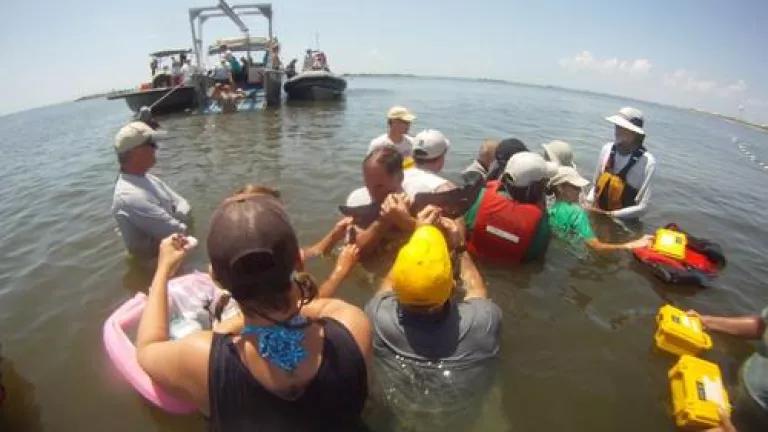
More than one year after the Deepwater Horizon was capped, biologists in the Gulf of Mexico are trying to determine what has happened to the dolphins—which continue to turn up dead in alarmingly high numbers along the coast, from Louisiana to Florida. Their latest effort is an extraordinary health assessment led by NOAA, focused on bottlenose dolphins in Barataria Bay, Louisiana. The rich bay waters were a battleground in the attempt to control the spill last year.
Here’s what we know so far. Hundreds of bottlenose dolphins have died in a series of mass mortality events in the northern Gulf of Mexico since Feburary 2010. The first event, troubling in itself, was already underway two months before the Deepwater Horizon exploded. Mortalities spiked again during the spill, which happened to occur at the beginning of the dolphins’ reproductive cycle, when much of the coastal population moves nearer to shore.
The third spate of strandings—which included unusually high concentrations of stillbirths and neonates—came at the start of the dolphins’ calving season, in January. Scientists have speculated that the dolphins’ ingestion or inhalation of oil, perhaps in combination with other factors, may ultimately be responsible. And while the number of stillbirths declined with the end of the calving season, the dolphins continue to strand in numbers six or more times the historic monthly average, at a rate that rivals the loss during the spill itself. In all, between February 2010 and August 2011, about 500 dolphins have stranded, nearly all of them found dead, and that number does not include, of course, the ones that died at sea but did not make it to shore. At least four more dolphins, including a pregnant female and a mother and calf, were discovered on Alabama beaches in the past week alone.
It is difficult to think of a mass mortality that has lasted as long, has involved so many animals, and has taken down so many calves.
Determining the health of the Gulf’s bottlenose dolphins is a matter of urgency. As I’ve written before, the dolphins that make their homes in the Gulf’s coastal waters and estuaries represent about three dozen separate communities, some smaller than 100 animals in size, and all extremely vulnerable. But pathologists can tell only so much from a distance, whether from behavioral observation or remote biopsy. For example, they cannot easily detect possible sublethal or latent effects, such as organ damage and immune dysfunction, which could link the strandings to the spill.
Since August 1st, the government has caught, physically examined, and released at least thirty bottlenose dolphins in the bay, performing a number of tests to get at the possible sublethal and chronic effects of the BP disaster. For example, scientists are testing samples of dolphin skin, blubber, urine, feces, blood, and blowhole swabs for polycyclic aromatic hydrocarbons—a toxic component of oil that causes birth defects in humans and may be to blame for the baby dolphin deaths between January and June.
The same team of veterinarians, biologists, and wildlife epidemiologists conducting the physical exams will also conduct diagnostic ultrasounds to map the dolphins’ internal organs and then tag their dorsal fins with radio beacons and satellite transmitters, to gather data on their behavior and movements over time. The findings will be compared with data from wild dolphins in Sarasota Bay, Florida, that have not been exposed to Macondo oil.
Hopefully the investigations will shed more light on these devastating strandings, inform future recovery efforts—and help hold any culpable parties accountable.